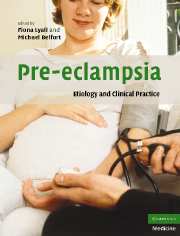Book contents
- Frontmatter
- Contents
- List of contributors
- Preface
- Part I Basic science
- Part II Clinical Practice
- 17 Classification and diagnosis of pre-eclampsia
- 18 Measuring blood pressure in pregnancy and pre-eclampsia
- 19 Immune maladaptation in the etiology of pre-eclampsia; an updated epidemiological perspective
- 20 Genetics of pre-eclampsia and counseling the patient who developed pre-eclampsia
- 21 Thrombophilias and pre-eclampsia
- 22 Medical illness and the risk of pre-eclampsia
- 23 The kidney and pre-eclampsia
- 24 Management of mild pre-eclampsia
- 25 Management of severe pre-eclampsia
- 26 The differential diagnosis of pre-eclampsia and eclampsia
- 27 Complications of pre-eclampsia
- 28 Central nervous system findings in pre-eclampsia and eclampsia
- 29 Pathogenesis and treatment of eclampsia
- 30 Anesthesia for the pre-eclamptic patient
- 31 Critical care management of severe pre-eclampsia
- 32 The role of maternal and fetal Doppler in pre-eclampsia
- 33 Pregnancy-induced hypertension – the effects on the newborn
- 34 Medico-legal implications of the diagnosis of pre-eclampsia
- Subject index
- References
23 - The kidney and pre-eclampsia
from Part II - Clinical Practice
Published online by Cambridge University Press: 03 September 2009
- Frontmatter
- Contents
- List of contributors
- Preface
- Part I Basic science
- Part II Clinical Practice
- 17 Classification and diagnosis of pre-eclampsia
- 18 Measuring blood pressure in pregnancy and pre-eclampsia
- 19 Immune maladaptation in the etiology of pre-eclampsia; an updated epidemiological perspective
- 20 Genetics of pre-eclampsia and counseling the patient who developed pre-eclampsia
- 21 Thrombophilias and pre-eclampsia
- 22 Medical illness and the risk of pre-eclampsia
- 23 The kidney and pre-eclampsia
- 24 Management of mild pre-eclampsia
- 25 Management of severe pre-eclampsia
- 26 The differential diagnosis of pre-eclampsia and eclampsia
- 27 Complications of pre-eclampsia
- 28 Central nervous system findings in pre-eclampsia and eclampsia
- 29 Pathogenesis and treatment of eclampsia
- 30 Anesthesia for the pre-eclamptic patient
- 31 Critical care management of severe pre-eclampsia
- 32 The role of maternal and fetal Doppler in pre-eclampsia
- 33 Pregnancy-induced hypertension – the effects on the newborn
- 34 Medico-legal implications of the diagnosis of pre-eclampsia
- Subject index
- References
Summary
The healthy kidney undergoes considerable vascular adaptation in pregnancy and it is therefore not surprising that pre-eclampsia, with widespread endothelial dysfunction, is associated with substantial renal consequences, an understanding of which provides insight into the overall vascular pathology. It is important to interpret impaired renal function secondary to pre-eclampsia in the context of the substantially enhanced renal performance of normal pregnancy, otherwise significant end organ damage in pre-eclamptic patients will go unrecognized.
The pathological renal characteristics of pre-eclampsia
It has been recognized for almost a century that pre-eclampsia is associated with morphological renal changes. Lohlein in 1918 noticed that glomeruli in autopsy specimens from pre-eclamptic patients were enlarged and had a thickened basement membrane. The precise nature of the pathological lesion was not determined until the introduction of the electron microscope. The classical pathology we now recognize to be associated with pre-eclampsia is that of endothelial vacuolization and hypertrophy of the cytoplasmic organelles classically described by Spargo et al. (1959) as “glomerular capillary endotheliosis.” Many original studies used biopsy specimens but there is one particularly notable post-mortem series by Sheehan and Lynch (1973). This was remarkable in that the autopsies were generally performed between 15 min and 2 h following death, thus minimizing histological artefact from tissue decomposition and biopsy techniques.
The ultrastructural renal consequences of pre-eclampsia are primarily seen in the glomerulus. The glomerulus is large and bloodless, an appearance compatible with gestational hypertension of any cause, but it is particularly marked in pre-eclamptic specimens.
- Type
- Chapter
- Information
- Pre-eclampsiaEtiology and Clinical Practice, pp. 339 - 356Publisher: Cambridge University PressPrint publication year: 2007



